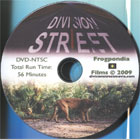
Division Street 2009
Distributed by The Video Project, PO Box 411376, San Francisco, CA 94141-1376; 800-475-2638
Produced by Eric Bendick
Directed by Eric Bendick
DVD, color, 56 min.
Jr. High - Adult
Animal Behavior, Environmental Studies, Transportation
Date Entered: 01/25/2010
Reviewed by Cliff Glaviano, Coordinator of Cataloging, Bowling Green State University Libraries, Bowling Green, OHTo document a project on road ecology, the impact of paved roads on wildlife, Eric Bendick decided to film the most remote location in the United States. Ironically, 44° 8.83’ N, 110° 4.45’ W, the point in the lower 48 furthest from the nearest road, is located in an area of Yellowstone National Park known as the Thorofare Area, named to reflect its historic importance as a pioneer and Native American travel corridor between Jackson Hole and points North. Highways often have a “barrier effect” on wildlife, sometimes splitting local populations and creating local extinctions. Since the National Interstate and Defense Highways Act of 1956 was passed long before the first Earth Day, and long before modern ecology, most roads, interstate and local, were constructed without regard to migrations or adaptive movements of wildlife populations.
Bendick and two companions hiked more than 22 miles from their trailhead parking lot to the most roadless location, filming spectacular scenery and wildlife along the way. The contrasts to Bendick's non-destructive incursion into wildlife habitat include interviews with an RCMP patrolman who routinely investigates car/animal collisions Alberta; planned construction of 42 wildlife overpasses or underpasses on roads in Montana's Flathead Indian Reservation; recent roadkill deaths of 17 Florida panthers along the Tamiami Trail from a population estimated at 100; and a discussion of how light rail or subways could eliminate the six lane parking lot that I-4 in Orlando becomes at rush hour. Experts interviewed include Dr. Richard Forman, Harvard landscape ecologist; Dr. Marty Main, wildlife ecologist, University of Florida; and Linda Chapin, Metropolitan Center for Regional Studies, University of Central Florida.
The scope of the video is huge. It briefly discusses the Yellowstone to Yukon Project envisioned as linking the wildlife islands of Yellowstone, Glacier, and Banff National Parks; the possibilities of creating greenways between national parks, national forests and wildlife refuges in the East; and the degree of leadership, resources and commitment that will allow an increasingly urban population (increasing from 3 billion to 5 billion by 2030) to coexist and even enjoy wild areas and wildlife. All this is told through spectacular scenery, incredible views of threatened and endangered wildlife, seen through the filter of a quirky but charming view of our present circumstances. Can the gray of the highways and the green of wildlife habitat coexist? We hope so. Will future generations be able to echo Eric’s companion hiker’s comment on the remote location in Thorofare Valley? Calling it the “kind of place it’s hard to leave not changed in some way.” Division Street is highly recommended.